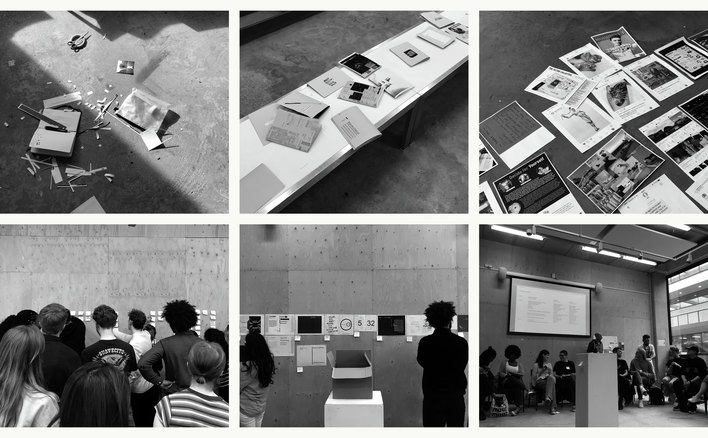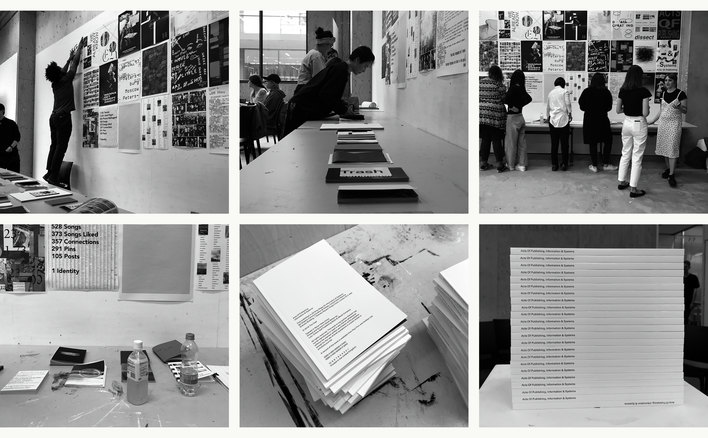Journal
Acts Of Publishing

Paul is the Information & Systems Platform Leader on the BA (Hons) Graphic Communication Design at Central Saint Martins, London. He has been busy writing the curriculum for the Information & Systems platform, and exploring various approaches to running workshops, through which students engage with key themes and approaches within the project brief.
The project ‘Acts Of Publishing’ has been developed to challenge the ‘over-thinking and under-making’ mindset that can take hold of students in the later half of Stage 02. So this project explores ‘under-thinking and over-making’ that corresponds to 10 Rules for Students, Teachers, and Life by John Cage and Sister Corita Kent, especially:
• Rule 7: The only rule is work. If you work it will lead to something. It’s the people who do all of the work all of the time who eventually catch on to things.
• Rule 8: Don’t try to create and analyse at the same time. They’re different processes.
Date
- 04.05.18
Introduction
Publish (verb)
1a to produce (a book, newspaper, etc) or release (it) for sale or distribution to the public. b to print (information, an article, a letter, etc) in a book, newspaper, etc. c to issue the work of (an author). 2a to make information generally known. b to announce (something) publicly. 3 to communicate (something libellous or defamatory about somebody) to another person.
— The New Penguin English Dictionary (2000)
Never before has the means of publishing been so available, accessible and affordable: from home printers, local copy shops to print-on-demand services (Lulu, Blurb, CreateSpace) to numerous free blogging software (WordPress,Tumblr, Medium) to social media platforms (Twitter, Facebook, Instagram, SnapChat). The act of publishing once reserved for the wealthy and powerful is now part of our everyday reality.
Within our technological reality we engage in numerous acts of intentional and unintentional publishing, through our various data trails: status updates, Instagram posts, text messages, e-mails, phone calls, card payments, contactless payments, loyalty cards, travel journeys, Google searches, browser histories, Amazon purchases, signing in to various online services. All these daily interactions or ‘acts of publishing’ produce valuable data that can be mined, analysed or sold. We are reduced to statistical data which informs organisations and corporations how to serve or exploit our consumer behaviour more effectively.
This has been in the News with the recent Facebook and Cambridge Analytica scandal and last year’s EU General Data Protection Regulation (GDPR) aimed to protect and empower all EU citizens data privacy and to reshape the way organisations across the region approach data privacy.
The only rule is work
The project was structured through a series of practical workshops or Acts. In the first Act students produced a 12page A5 publication that contained material they had gathered:
• 5x images that they had posted, liked, taken, shared or viewed.
• 5x texts that they had posted, emailed, texted, retweeted, read, copied, bookmarked or saved.
• 5x data; how many steps they have taken, or films watched, money spent, miles traveled.
• A3 mindmap of a comprehensive brainstorm of all the unforeseen acts of publishing that they generate on a given day.
The students then had 1 week to produce a 100page publication that developed, challenged, extended, subverted or questioned the workshop & brief. They produced lots of amazing work, we then rather cruelly tasked them to boil down their 100page publication and condense, consolidate and collapse it back into another 12page A5 publication. Based on their new focused publication students identified key themes that they were exploring, and through a rather hectic workshop they identified the following 5 themes that encompassed all of their enquiries:
• Fictions
• Data
• Time
• Identity
• Space
Students then located themselves in one of these themes, and were given the following instructions:
The book will be structured in 5 Acts
Each Act:
1. Is a Chapter
2. Represents / responds to a Theme
3. Contains 6—7 Characters (students)
4. Comprises of 12 —14 double page spreads (or 2 double pages spreads (4 single pages) per character)
5. The Characters decide / design what happens in their Act.
6. The Characters have 4 days to finalise their Act.
7. Each Character submits a cover design for an anonymous selection procedure.
The book acts as the performance of the project.
THE ACTS

THE PUBLICATION
